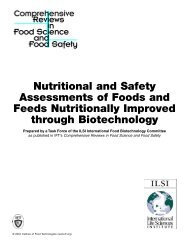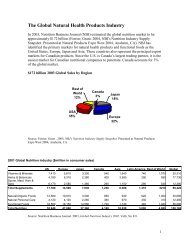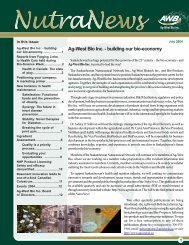Beyond Borders: Global biotechnology report 2010
Beyond Borders: Global biotechnology report 2010
Beyond Borders: Global biotechnology report 2010
Create successful ePaper yourself
Turn your PDF publications into a flip-book with our unique Google optimized e-Paper software.
Australian <strong>biotechnology</strong> at a glance, 2008–09 (US$m)<br />
Public company data 2009 2008 % change<br />
Revenues 3,721 3,475 7%<br />
R&D expense 417 436 -4%<br />
Net income (loss) 545 319 71%<br />
Number of employees 11,060 10,110 9%<br />
Market capitalization 18,597 21,557 -14%<br />
Total assets 7,082 6,339 12%<br />
Number of public companies 74 83 -11%<br />
Source: Ernst & Young and company financial data<br />
the bulk of this improvement, the rest of<br />
the industry held steady. Without CSL,<br />
the industry’s net loss in US dollars was<br />
essentially flat during the year.<br />
The net income story was driven at least<br />
in part by companies’ cost-cutting efforts<br />
in the current economic environment.<br />
As in the US, Europe and Canada, this<br />
was reflected in R&D expenditures. The<br />
industry’s R&D spending declined by 4%,<br />
from US$436 million in 2008 to US$417<br />
million in 2009. Without CSL (which<br />
increased R&D spending by 38% during this<br />
period), the industry’s R&D expenditures<br />
would have declined by a far steeper 22%.<br />
A transformational year<br />
In more ways than one, 2009 has indeed<br />
been a transformational year for the<br />
<strong>biotechnology</strong> industry. After years of<br />
double-digit increases on the top line,<br />
the industry’s revenue growth slowed<br />
considerably. With a forecasted slow recovery<br />
for the global economy and mounting pricing<br />
pressure on drugs, the downward pressure<br />
on revenues — in the absence of new<br />
breakthrough therapeutics — could well be<br />
part of the new normal for years to come.<br />
R&D spending will remain an important<br />
driver. Biotech remains an innovationdriven<br />
business, and R&D is inherently<br />
unpredictable. While companies and<br />
investors will, and should, continue to<br />
look for more efficient ways to develop<br />
products in the new normal (see the <strong>Global</strong><br />
introduction article for more details), drastic<br />
reductions in R&D spending could result in<br />
lower levels of innovation and new product<br />
introductions in years ahead — with negative<br />
repercussions not just for the industry’s<br />
performance, but also for its ability to<br />
attract investors.<br />
The encouraging news, though — and<br />
perhaps the biggest transformation of<br />
all — is in the industry’s bottom line. Net<br />
income was boosted considerably by costcutting<br />
efforts, which are likely to continue<br />
given the more challenging fund-raising<br />
environment. Much of the cost cutting<br />
in 2009 was precipitated by short-term<br />
thinking and the very real need to survive.<br />
In many cases, companies may well have<br />
overreacted — trimming not just fat, but<br />
R&D muscle and bone as well. However,<br />
as biotech finds a new equilibrium, we<br />
are likely to see a middle ground emerge,<br />
where the industry continues to develop<br />
groundbreaking innovations but finds<br />
more efficient approaches and business<br />
62 <strong>Beyond</strong> borders <strong>Global</strong> <strong>biotechnology</strong> <strong>report</strong> <strong>2010</strong><br />
models for commercializing products and<br />
technologies. That would be good news<br />
indeed — not just for biotech companies<br />
but for the investors who back them and<br />
the patients who need their innovative<br />
new products.








